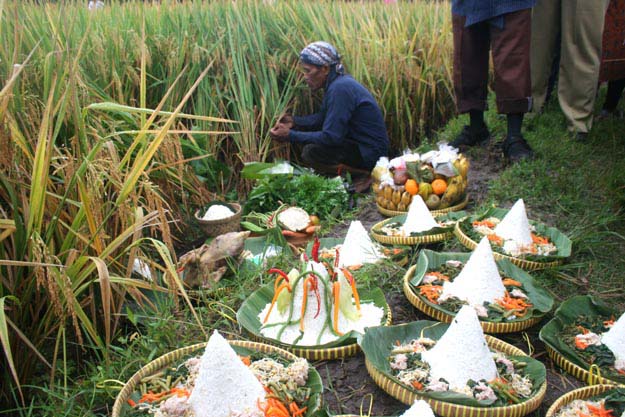The Wiwitan Tradition: Harvest ‘Syukuran’ Rituals That Still Go On Today

The Wiwitan tradition is a ceremony of gratitude for the abundance of rice
(Istimewa)The tradition of giving thanks or ‘syukuran’ in Indonesia is an event held to show gratitude for the abundance of riches to God by holding a ceremonial feast. For some parts of the world, like the United States, thanksgiving is done by holding dinner with family and loved ones every year. In Indonesia, thanksgiving or ‘syukuran’ is held on every big occasion such as the birth of a child or a wedding ceremony, where they show their gratitude by holding a feast and sharing with those less fortunate.
Syukuran is also a big tradition for Indonesian farmers every year. Usually, it’s held at the start of the harvesting season with a big elaborate ceremony celebrated by the farmer and villagers. One example of this ‘syukuran’ ceremony is the Wiwitan tradition in Delanggu, Klaten, Central Java.
Getting to know the Wiwitan tradition
The Wiwitan tradition is a ceremony of gratitude for the abundance of rice that is held as the sign of the start of every harvesting season. It also includes a praying ceremony for an abundance and healthy harvest free of pests for the next planting season. The ceremony starts with parading ‘mountains’ or piles of harvest from the earth and giant ogoh-ogoh made of straw. This parade is called the ‘kirab budaya’, where participants walk with the harvest and ogoh-ogoh for two kilometers around the village.

After the parade, the main Wiwitan tradition or ceremony is to start at the rice fields. The ceremony begins with cutting a few stalks of rice using ani-ani, a traditional device made of wood and a tiny blade that cuts the stalks of the rice paddy one by one. This ceremonial part of the event starts the harvesting process and is followed by a dance performance in the rice fields.
On the same occasion, the villagers also prepared five hundred servings of wiwit rice. Wiwit rice is a dish that contains savory rice, eggs, vegetables, and other traditional side dishes that are shared with the villagers. This part of the celebration is the most popular with the wiwit rice being gone after only a couple of hours.
This syukuran tradition is the highlight of the 2022 Mbok Sri Mulih Festival organized by the Rojolele Delanggu Studio. The Mbok Sri Mulih Festival, held annually for the past five years, is filled with activities surrounding the rojolele rice, a staple product of the Delanggu region. Activities such as culinary workshops are also held on top of the ‘kirab budaya’ and wiwit tradition.
Tips so that the harvest is always abundant
The point of the ‘syukuran’ ceremony is to give thanks and pray for an abundant harvest in the future. It is a great practice of gratitude and sharing that respects the gift of food from God. But to keep maintaining the abundance of harvest, it should also include other efforts to increase a healthy crop yield. Here are a few tips to produce an abundant harvest shared by IDN Indonesia.
- Use high-quality seeds. Every healthy plant starts with a good seed. Like farmers in the Delanggu region, they primarily planted the rojolele variety and its derivatives on their land. This is due to the rice characteristic that is native and thriving in the region. So when it comes to choosing the seeds, try to keep in mind the climate and characteristics of the soil and the seed itself to achieve an abundant harvest.
- Sow seeds that have germinated. Planting from seeds is not entirely wrong, but a germinated seed has a better chance of growing strong than seeds because it already has the foundation to grow and it doesn’t have to compete with other elements in the soil for nutrition. Nutrition such as nitrogen in the soil is important for creating cells for growing plants, if a seed is introduced to rich soil with other microorganisms, it can have a harder time fulfilling its nutritional needs and will have a harder time growing.
- Clean up the land before planting. Be it in a garden or straight into the soil, land management is important to help plants grow. Clean the soil from other plants and weeds beforehand, as these plants will compete with the seeds for nutrients. It also helps to add compost or pesticide for a few days to get rid of pest threats and give the soil a boost of nutrients.
- Maintain plant health with water and fertilizer. After planting and letting the seed establish itself, now it’s time to maintain its health by providing enough access to sunlight, enough water, and fertilizer. Sunlight and water are a big part of the plant’s growth and ability to produce. Depending on the type of plants, watering can be adjusted as needed. The main thing to remember is to not overwater them. Overwatering can lead to diseases such as root rot and invites the presence of pests and diseases. While fertilizer supplies the plant with nutrients to make them stronger and produce high-quality fruits.
Fertilizer recommendations to increase crop yields
Fertilizers supply plants with important nutrients for them to grow and produce. For example, nitrogen is helpful for young plants, along with a balanced level of all other nutrients like potassium and phosphorus.
Supplying plants with nutrients is a year-round need for plants. While each plant’s needs might differ, the umbrella rule for fertilizer according to the International Fertilizer Development Center is to remember the 4R, Right source, Right amount, Right time, and Right placement. Here are a few guidelines on what nutrients a plant needs according to its growth stages.
- Newly planted can benefit from fertilizer that contains a higher amount of root-supporting nutrients, like phosphorus and potassium.
- Blossoming or flowering can benefit from a fertilizer with phosphorus, potassium, and calcium.
- Fruiting can benefit from fertilizer that contains a decent amount of phosphorus and potassium while reducing the amount of nitrogen.
Each stage of growth requires a different amount of nutrients and composition. It is why plants will benefit from an NPK fertilizer that can be customized according to their nutrient needs. (Safaanah)
